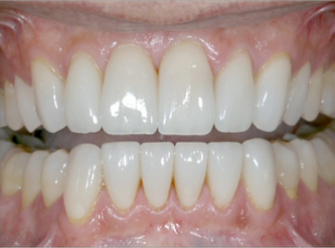 For most patients the outcome of excess overjet is some occlusal variation from what might be considered normal or ideal. The specific variation is dependent upon how each individual compensates to the excess overjet.
For most patients the outcome of excess overjet is some occlusal variation from what might be considered normal or ideal. The specific variation is dependent upon how each individual compensates to the excess overjet.
There are three common forms of compensation. Perhaps the most common change would be over-eruption of the maxillary or mandibular anteriors, or both. This variation results in an excessively deep overbite that is in fact the result of the excess overjet allowing the teeth to over-erupt. Another variation is a lack of eruption resulting in an anterior open bite. Presumably in these patients something is preventing the teeth from erupting. Some possible causes may be the tongue, excursive contacts, or the final variation, a patient who develops a habitual intercuspal position that is placed anterior enough that it negates the open bite.
In these patients the excess overjet is not visible unless the patient moves into a more retruded position. There are risks involved when treating any of these variations, but the risks are different for each.
Eruption with the development of a deep overbite: In patients whose excess overjet leads to eruption and a deep overbite the primary risks are to the anterior teeth. Whenever a patient has a deep overbite several different signs or symptoms may develop. Some examples include: potential esthetic changes such as excessive tooth and gingival display, pathway wear, or wear on the lingual of the maxillary anterior teeth and facial of the mandibular anterior teeth, mobility or fremitus of the maxillary anterior teeth, sensitivity of the maxillary anterior teeth, and finally sometimes lateral pterygoid muscle hyperactivity resulting in pain in front of the ear over the TMJ.
If these symptoms exist treatment should attempt to reduce the overbite and create more freedom in the pathways of movement. It should be noted that in most cases of a deep overbite the posterior teeth are actually protected by the immediate anterior guidance and not at risk. It is important to note that there are many patients who have a deep overbite and never develop any of these problems.
Lack of eruption and an anterior open bite: When the patient's anterior teeth don't erupt and an anterior open bite exists, a new set of risks are present, this time on the posterior teeth. Since there is no anterior contact the ability of the anterior teeth to guide the occlusion and separate the posterior teeth during excursions is reduced. Because of this these patients may show all the signs and symptoms of occlusal trauma to posterior teeth, fractures, mobility, wear, as well as advanced periodontal issues if they are susceptible. Again it is important to note that there are many patients with anterior open bites who are completely asymptomatic.
An anteriorly positioned intercuspal position: In some patients who have excess overjet, particularly those who are skeletally Class II, they adapt by choosing a habitual position of intercuspation that appears Class I, there is no open bite and no anterior over-eruption. In these patients the largest risks is typically to their posterior teeth, specifically if their mandible retrudes and they have any parafunction in the retruded position the only occlusal contact may be on the molars, which can show significant wear, fractures, or mobility.